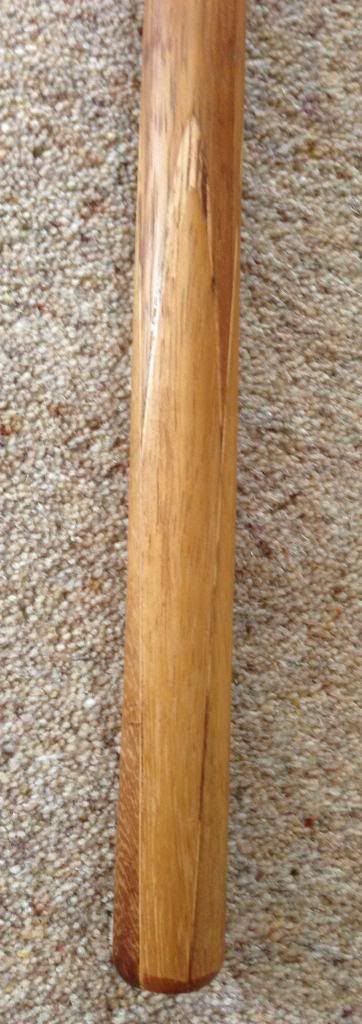Thanks for your comment. Picked up some bits of wood today - ebony, olive, zebrano and padauk. Hopefully enough to make a few more cues. Got a bit bored with the design of the first cue so decide to double splice it with vaneers. Nearly finished it so fingers crossed it comes out ok.
Announcement
Collapse
No announcement yet.
Tips on making cues
Collapse
X
-
Not bad at all . Personally I do not think the Zebrano is either strong enough or wide enough to delineate the butt wood from the secondary splices. A wider veneer or a darker secondary splice or darker butt would help. The colours are too similar and the veneer is lost.Have you any coloured veneers , that could work as well.
Comment
-
As the man said it was done for prctice more than anything else and I'm sure he doesnt want to waste his best woods/venneers at this stage. Its all about getting the splices even till he's ready to try for the real deal.
Well done mate."When everything seems to be going against you, remember that the airplane takes off against the wind, not with it." - Henry Ford
Comment
-
I couldn't agree more, however this was just a practice to check my methods etc before begining a cue with better timbers.Originally Posted by old school View PostNot bad at all . Personally I do not think the Zebrano is either strong enough or wide enough to delineate the butt wood from the secondary splices. A wider veneer or a darker secondary splice or darker butt would help. The colours are too similar and the veneer is lost.Have you any coloured veneers , that could work as well.
Comment
-
I appreciate your honesty and the fact that you are open to suggestion , especially if the criticism is constructive and is meant to help you.I like what you did in that you used less expensive timbers to experiment and my suggestion for wider or darker veneers was also to point out that if you had clear delineation between the woods you would also see , more easily ,how acurate your splicing was. Perhaps Padauk between main and secondary splices ( or ebony , or a dark rosewood ) would help to show off your splice work better , even though the main and secondary splices were so similar in colour. Did you use Iroko for both sets of splice work ?
Comment
-
Thanks for the suggestion. The splicing wasn't 100% accurate basically the front and back are identical lengths to each other, likewise the two sides are to each other. The approximate difference in length is 3mm. However this could be down to my planning as i think the taper on the sides at the splice point is just ever so slightly thinner. its difficult for me to tell as i dont have a micrometer. For the next one i think I'm going to just do a single front splice (posiibly padauk) with a thick veneer and ebony butt. In answer to one of your earlier questions the only veneer I currently have is the zebrano as I had some left over from another project. The timber on the extra four splices isn't iroko. It's either afromosia or teak can't remember which, just an off cut from something I had. All very similar woods so do blend in.
Comment
-
Afromosia is also known as African Teak , although the two species i.e. Teak & Afromosia are unrelated. They are similar in characteristics , grain pattern and colour and can be " worked " pretty much the same .Afromosia is often used and successfully so as a Teak substitute , however a word of caution Afromosia can be harmful to your health when working it .Eye , skin and respiratory problems can occur , as well as splinters getting more easily infected , although this is rare it does happen. If you go to Craftsmans cues website and look up the Brittania cues section there is a picture of a hand spliced Rosewood butted cue with quad cream veneers and what looks like rosewood quad secondary splices.This cue kind of explains what I was trying to say in that you can visually see delineation and accuracy of splices just by looking.By the way I totally applaud your bravery in tackling quad splicing for a first cue , kudos ( pardon the pun) and it acheived what you wanted in that it provoked comment and proved that , basically , your " setting out " and methodology in the way you work is spot on.Please continue and share with us any future work.
Comment
-
Funny you should say this, I found out the last time I used the timber that I have a skin allergy to the dust so have to wear latex gloves and long sleeves when working with it. I also managed to spike a 3cm splinter into my index finger and for it come through the other side. lolOriginally Posted by old school View Posthowever a word of caution Afromosia can be harmful to your health when working it .Eye , skin and respiratory problems can occur , as well as splinters getting more easily infected , although this is rare it does happen.
Comment
-
It's been a couple of weeks now since the last cue. Have finally finished cue no.2. It's not perfect but I think a healthy improvement on the first. Much happier with the finish I've achieved. Grain is a little twisted by the splices for the first two arrows but after that its straight and the splices and flat are in line with the straight ones.
Specs: 58" long, ~32mm butt (quite chunky but the same as my spec) 9.5mm tip, 18.5 oz and 18.5-19" balance point.
Pics below and comments appreciated:





Comment
-







Comment